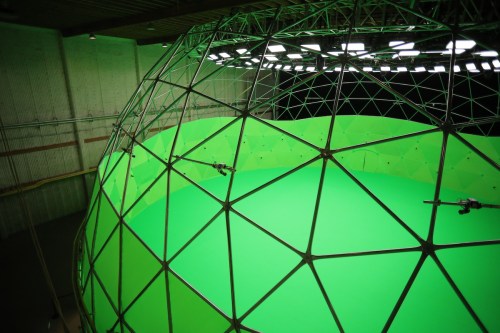
Hollywood isn’t exactly short of a studio lot or two. While diminished from its Golden Age height, thanks to the increased cost of once-cheap real estate and the popularity of shooting outdoors, it is still to be found dotted around Tinseltown; belonging to established giants like Warner Bros., Universal, and Paramount.
But the movie industry is changing — and the lot that’s referred to as the “world’s largest immersive media hub,” boasting an enormous, 10,000-square-foot-tall geodesic dome kitted out with 96 high-resolution 5K cameras for cutting-edge “volumetric capture” filmmaking, doesn’t belong to any of the Hollywood majors. Instead, it belongs to Intel. And it may just be the studio of the future.
“It opens a new kind of dimension with how you capture content, how you capture that performance and that artistic visualization”
Much as Intel processors are widely used to power the majority of today’s desktop and laptop PCs, so, too, could Intel Studios help power tomorrow’s creators as they make new kinds of film. As Diego Prilusky, general manager of Intel Studios, told Digital Trends, this is not a studio space for hire in the manner of, say, the U.K.’s famous Pinewood Studios.
“There’s not too many creators that can come, rent the space, and go in and start creating content,” he said.
Welcome to volumetric filmmaking
That’s because Intel’s volumetric capture technology is, for the majority of filmmakers, a new way of recording: With each of the facility’s 5K cameras capturing action in two dimensions, before its proprietary algorithms convert the resulting trillions of pixels to 360-degree virtual environments. Ever seen the footage of the rig used for recording The Matrix’s famous “bullet time” sequences two decades ago? Intel Studios’ technology is capable of recording that kind of three-dimensional performance data on a scale that would have been, frankly, unimaginable at the time. Where a regular film shoot might record scenes with a handful of cameras at a time, the enormous number of cameras in Intel’s facility makes it easy to record ultra high-quality images in three dimensions.
Once the footage has been captured, Intel Studios sends this volumetric content across some five miles of fiber-optic cables to upward of 90 Intel-powered servers able to crunch a massive terabyte of data in under 10 seconds. Eventually, the plan is for the Intel Studio servers to be capable of storing up to 10 petabytes of data. This is equivalent to some 133 years of high-definition video.
Prilusky said that the way that sound and image are recorded has been streamlined over the years. However, volumetric capture represents a major shift in this journey. It’s not simply about the way that the images are recorded, but also the form in which they are shown: Not just passive viewing experiences, but immersive three-dimensional stories that can be viewed from inside the scene, with the viewer more like a person standing among actors on a stage than sitting in front of a TV in their living room.
“We are very familiar with how we record audio and video,” Prilusky said. “Now we’re moving to a much more interactive environment, with more interactive devices. There’s the ability to navigate through three-dimensional space. … It opens a new kind of dimension with how you capture content, how you capture that performance and that artistic visualization aspect in a form that could be exploited in [these new forms of] digital navigation and digital interaction.”
Just call it “entertainment”
It’s still early days for Intel Studios when it comes to production. The downside of being on the bleeding edge is that being able to offer this content to viewers is tough. As the science-fiction author and futurist William Gibson once noted, the future may be here, but it’s not yet evenly distributed. Things are starting to change, though. At August’s Venice International Film Festival, one of the world’s oldest and most established film festivals, Intel Studios premiered two new volumetric VR films, Queerskins: ARK and HERE. In both, the viewers were able to explore immersive virtual environments. Previously, Intel Studios has shown off its productions at Tribeca Film Festival and Cannes.
The results are a combination of films, graphic novels (HERE is an adaptation of Richard McGuire’s graphic novel of the same name) and gaming. This, ultimately, could turn out to be the kind of filmmaking Intel Studios helps to create: a hybrid that converges multiple forms of media into one new type that could define the decades to come. “[Maybe, we’ll just] call it entertainment,” he said. “Pure entertainment.”
The current COVID-19 impact on theaters has caused the entertainment industry to change quickly in ways that would have seemed impossible just a few years ago. With theaters shuttering and services like Netflix continuing to go from strength to strength (including experimenting with innovative branching formats like 2018’s branching-narrative Bandersnatch), new forms of entertainment are in the process of emerging.
Thanks to Intel, we have some idea of what they might look like. And where they’ll be made.
Editors' Recommendations
- How do you film what isn’t real? Joe Hunting on his documentary We Met in Virtual Reality
- The visually impaired can now watch Comcast TV channels on VR goggles